

Sony high-res OLED screen attaches to any eyewear. If you're not a fan of Google Glass-style displays yet, Sony hopes you might give its new detachable OLED a chance.
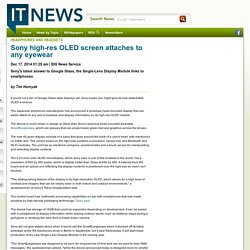
The Japanese electronics manufacturer has announced a prototype head-mounted display that can easily attach to any sort of eyewear and display information on its high-res OLED module. The device is much closer in design to Glass than Sony's previous head-mounted wearable, SmartEyeglasses, which are glasses that can project basic green text and graphics across the lenses. The new 40-gram display consists of a band that goes around the back of a user's head, with electronics on either arm. The control board on the right side contains a processor, sensor hub and Bluetooth and Wi-Fi modules.
The unit has an electronic compass, accelerometer and a touch sensor for manipulating and selecting display contents. The control board has "arithmetic processing capabilities on par with smartphones that was made possible by high-density packaging technology," Sony said. Build a $35 Media Center with Raspbmc and Raspberry Pi, Redux. Last year we showed you how to turn the Raspberry Pi into a silent, snappy, and all around awesome media center.
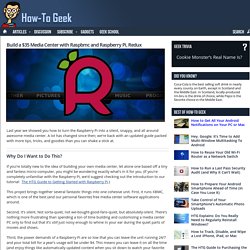
A lot has changed since then; we’re back with an updated guide packed with more tips, tricks, and goodies than you can shake a stick at. Why Do I Want to Do This? If you’re totally new to the idea of building your own media center, let alone one based off a tiny and fanless micro-computer, you might be wondering exactly what’s in it for you. (If you’re completely unfamiliar with the Raspberry Pi, we’d suggest checking out the introduction to our tutorial: The HTG Guide to Getting Started with Raspberry Pi.) This project brings together several fantastic things into one cohesive unit. Second, it’s silent. Third, the power demands of a Raspberry Pi are so low that you can leave the unit running 24/7 and your total bill for a year’s usage will be under $4. Finally, both the Raspberry Pi (the hardware) and Raspbmc (the software) have matured a lot in the last year.
What Do I Need? 4 Ways to Free Up Disk Space on Linux. Linux systems aren’t as light on disk space as they could be.
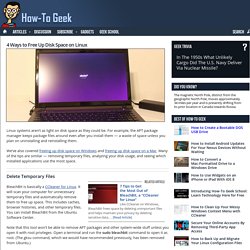
For example, the APT package manager keeps package files around even after you install them — a waste of space unless you plan on uninstalling and reinstalling them. We’ve also covered freeing up disk space on Windows and freeing up disk space on a Mac. Many of the tips are similar — removing temporary files, analyzing your disk usage, and seeing which installed applications use the most space.
Delete Temporary Files BleachBit is basically a CCleaner for Linux. Note that this tool won’t be able to remove APT packages and other system-wide stuff unless you open it with root privileges. One of the nicest things about BleachBit is that it automates some things that only experienced Linux users would normally think to do. 5 Things You Need to Know About Ubuntu 14.04 LTS. Ubuntu 14.04 LTS is the latest release of Ubuntu.
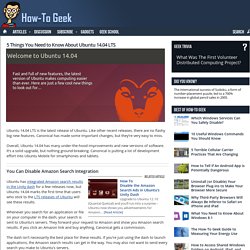
Like other recent releases, there are no flashy big new features. Canonical has made some important changes, but they’re very easy to miss. Overall, Ubuntu 14.04 has many under-the-hood improvements and new versions of software. It’s a solid upgrade, but nothing ground-breaking. Canonical is putting a lot of development effort into Ubuntu Mobile for smartphones and tablets. You Can Disable Amazon Search Integration Ubuntu has integrated Amazon search results in the Unity dash for a few releases now, but Ubuntu 14.04 marks the first time that users who stick to the LTS releases of Ubuntu will see these results. Whenever you search for an application or file on your computer in the dash, your search is sent to Ubuntu’s servers. The dash isn’t necessarily the best place for these results. Use VirtualBox’s Seamless Mode or VMware’s Unity Mode to Seamlessly Run Programs From a Virtual Machine. Virtual machines generally run guest operating systems and their programs in a single window.
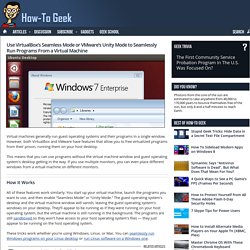
However, both VirtualBox and VMware have features that allow you to free virtualized programs from their prison, running them on your host desktop. This means that you can use programs without the virtual machine window and guest operating system’s desktop getting in the way. If you use multiple monitors, you can even place different windows from a virtual machine on different monitors.
How It Works All of these features work similarly. These tricks work whether you’re using Windows, Linux, or Mac. Using VirtualBox’s Seamless Mode Note that VirtualBox only allows you to use this feature with Windows, Linux, and Solaris guests. Before using this feature, you must install the VirtualBox Guest Additions software package inside the guest virtual machine you want to do this with. To exit seamless mode, just press the host key and L again. Build a $35 Media Center with Raspbmc and Raspberry Pi. The HTG Guide to Getting Started with Raspberry Pi. Over the last year the Raspberry Pi, a cheap credit-card sized computer, has taken the computing and DIY world by storm.

Read on as we guide you through everything from buying to powering to running the tiny dynamo. What Is the Raspberry Pi? The Raspberry Pi is a credit-card sized general purpose Linux computer designed and manufactured by the Raspberry Pi Foundation, a non-profit organization dedicated to making computers and programming instruction as accessible as possible to the widest number of people. Although the original mission of the Raspberry Pi project was to get inexpensive computers with programming capabilities into the hands of students, the Pi has been embraced by a diverse audience.
Tinkers, programmers, and DIYers across the globe have adopted the tiny platform for projects ranging from recreating retro arcade cabinets to controlling robots to setting up cheap but powerful home media devices.